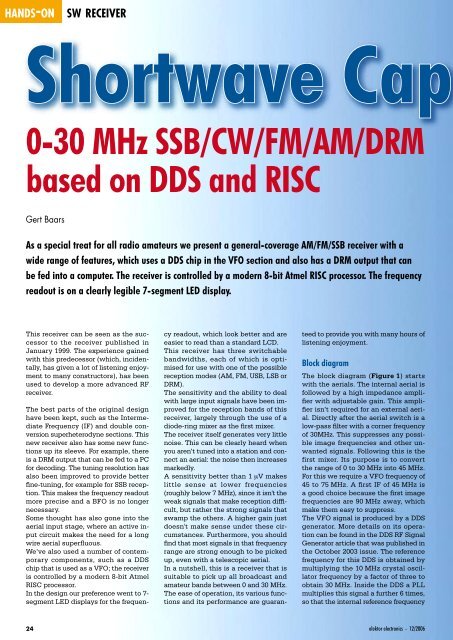Tune that dial - Index of
Tune that dial - Index of
Tune that dial - Index of
Create successful ePaper yourself
Turn your PDF publications into a flip-book with our unique Google optimized e-Paper software.
hands-on sw receiver<br />
Shortwave Cap<br />
0-30 MHz SSB/CW/FM/AM/DRM<br />
based on DDS and RISC<br />
Gert Baars<br />
As a special treat for all radio amateurs we present a general-coverage AM/FM/SSB receiver with a<br />
wide range <strong>of</strong> features, which uses a DDS chip in the VFO section and also has a DRM output <strong>that</strong> can<br />
be fed into a computer. The receiver is controlled by a modern 8-bit Atmel RISC processor. The frequency<br />
readout is on a clearly legible 7-segment LED display.<br />
This receiver can be seen as the successor<br />
to the receiver published in<br />
January 1999. The experience gained<br />
with this predecessor (which, incidentally,<br />
has given a lot <strong>of</strong> listening enjoyment<br />
to many constructors), has been<br />
used to develop a more advanced RF<br />
receiver.<br />
The best parts <strong>of</strong> the original design<br />
have been kept, such as the Intermediate<br />
Frequency (IF) and double conversion<br />
superheterodyne sections. This<br />
new receiver also has some new functions<br />
up its sleeve. For example, there<br />
is a DRM output <strong>that</strong> can be fed to a PC<br />
for decoding. The tuning resolution has<br />
also been improved to provide better<br />
fine-tuning, for example for SSB reception.<br />
This makes the frequency readout<br />
more precise and a BFO is no longer<br />
necessary.<br />
Some thought has also gone into the<br />
aerial input stage, where an active input<br />
circuit makes the need for a long<br />
wire aerial superfluous.<br />
We’ve also used a number <strong>of</strong> contemporary<br />
components, such as a DDS<br />
chip <strong>that</strong> is used as a VFO; the receiver<br />
is controlled by a modern 8-bit Atmel<br />
RISC processor.<br />
In the design our preference went to 7segment<br />
LED displays for the frequen-<br />
cy readout, which look better and are<br />
easier to read than a standard LCD.<br />
This receiver has three switchable<br />
bandwidths, each <strong>of</strong> which is optimised<br />
for use with one <strong>of</strong> the possible<br />
reception modes (AM, FM, USB, LSB or<br />
DRM).<br />
The sensitivity and the ability to deal<br />
with large input signals have been improved<br />
for the reception bands <strong>of</strong> this<br />
receiver, largely through the use <strong>of</strong> a<br />
diode-ring mixer as the first mixer.<br />
The receiver itself generates very little<br />
noise. This can be clearly heard when<br />
you aren’t tuned into a station and connect<br />
an aerial: the noise then increases<br />
markedly.<br />
A sensitivity better than 1 µV makes<br />
little sense at lower frequencies<br />
(roughly below 7 MHz), since it isn't the<br />
weak signals <strong>that</strong> make reception difficult,<br />
but rather the strong signals <strong>that</strong><br />
swamp the others. A higher gain just<br />
doesn't make sense under these circumstances.<br />
Furthermore, you should<br />
find <strong>that</strong> most signals in <strong>that</strong> frequency<br />
range are strong enough to be picked<br />
up, even with a telescopic aerial.<br />
In a nutshell, this is a receiver <strong>that</strong> is<br />
suitable to pick up all broadcast and<br />
amateur bands between 0 and 30 MHz.<br />
The ease <strong>of</strong> operation, its various functions<br />
and its performance are guaran-<br />
teed to provide you with many hours <strong>of</strong><br />
listening enjoyment.<br />
Block diagram<br />
The block diagram (Figure 1) starts<br />
with the aerials. The internal aerial is<br />
followed by a high impedance amplifier<br />
with adjustable gain. This amplifier<br />
isn’t required for an external aerial.<br />
Directly after the aerial switch is a<br />
low-pass filter with a corner frequency<br />
<strong>of</strong> 30MHz. This suppresses any possible<br />
image frequencies and other unwanted<br />
signals. Following this is the<br />
first mixer. Its purpose is to convert<br />
the range <strong>of</strong> 0 to 30 MHz into 45 MHz.<br />
For this we require a VFO frequency <strong>of</strong><br />
45 to 75 MHz. A first IF <strong>of</strong> 45 MHz is<br />
a good choice because the first image<br />
frequencies are 90 MHz away, which<br />
make them easy to suppress.<br />
The VFO signal is produced by a DDS<br />
generator. More details on its operation<br />
can be found in the DDS RF Signal<br />
Generator article <strong>that</strong> was published in<br />
the October 2003 issue. The reference<br />
frequency for this DDS is obtained by<br />
multiplying the 10 MHz crystal oscillator<br />
frequency by a factor <strong>of</strong> three to<br />
obtain 30 MHz. Inside the DDS a PLL<br />
multiplies this signal a further 6 times,<br />
so <strong>that</strong> the internal reference frequency<br />
24 elektor electronics - 12/2006

















